34 Best Exercises for Burning Calories Fast
When it comes to burning calories, exercise plays a crucial role in helping you achieve your weight loss or fitness goals. Regular physical activity not only aids in calorie burning but also offers numerous other health benefits, such as improving cardiovascular health, boosting mood, and increasing overall strength and endurance.
Calories are a unit of measurement for food’s amount of energy. The body needs calories to breathe, circulate blood, and engage in physical activity. A sick person’s body could require extra calories to combat a fever or other issues.
You can lose weight and keep it off by increasing your caloric expenditure. You can increase the total amount of calories you burn in less conventional ways in addition to exercising and eating the correct foods.
To achieve any fitness goal, there seem to be multiple workout available options. There is an approach to increase your cardiovascular endurance, improve well-defined muscles, complete a half-marathon, and enhance mobility, to mention a few. If reducing weight is your aim, you must know which workouts burn the most calories. Yes, some exercises burn calories much more effectively than others.
While some insist that strength training is the best fat burner, others champion cardio. The size of the sweat puddle on your mat and the number displayed after a session on your wristwatch or machine don’t always convey the whole story, though.
Any program for weight loss or keeping it off must include physical activity. Your body expends more energy (calories) when you are active. And you lose weight when you spend more calories than you take in.
If you are trying to burn the maximum calories, you should consider taking up running. Running is the foremost calorie-burning workout per hour.
If running isn’t what you like, other calorie-burning activities include high-intensity interval training (HIIT), rope jumping, and swimming. Depending on your interests and fitness level, you can perform any of the combinations of these exercises.
The amount of calories you burn is determined by various factors, including:
Activity duration, timing, intensity, weight, and height.
In general, the more you weigh, the greater number of calories you will burn while doing physical activity.
Work with an exercise professional if you want to know the actual figure. They may estimate your specific calorie burn during physical activity.
Table of Contents
Being More Active Burns More Calories:
Energy is required for every physical action. When you work harder, you burn more calories. Even moving around while sitting still burns more calories.
The number of calories a 170-pound (77-kilogram) person can burn through various activities is compared below.
Standing instead of sitting burns 186 calories as compared to 139 calories in sitting.
Standing burns 186 fewer calories than walking at an average speed (324 calories).
Walking speedily burns 371 calories more than walking slowly does (324 calories vs. 371 calories).
Find ways to move more frequently each day. Up to 100 calories or more can be burned each day with even little adjustments, like standing when on the phone as opposed to sitting. Create your own ideas after using the options below as a starting point.
Before beginning a new exercise program, especially if you are not currently exercising regularly, always with your health care practitioner.
34 Best Exercises for Burn Calories:
Walking:

Many people find walking to be enjoyable because of how easy it is, especially those who want to increase their caloric expenditure.
Your weight and walking speed are two important elements that affect how many calories you burn when walking. Adults typically walk at a speed of 3 mph (4.8 kph). The more calories you burn when walking, the faster you go and the more weight you have. Terrain, climate, as well as your age, and sex, are other variables that affect how many calories you burn.
You can burn calories by walking for an hour every day and thus reduce your weight. We advise engaging in at least 300 minutes of moderately vigorous physical exercise each week if you want to lose a significant amount of weight (greater than 5% of your body weight). You might be able to achieve that objective by walking for an hour each day.
If you want to walk for exercise every day, start off slowly and gradually increase the duration and frequency of your walks. When you are able to walk for as long and as often as you wish, you can step up the difficulty.
How much and how often you walk may also have an impact on your ability to lose weight. Although it can help you lose weight, walking is most effective with a calorie-restricted diet. In addition, many people commonly lose lean muscle mass as they lose weight. You can sustain your weight loss outcomes by walking to protect your lean muscle mass.
You must regularly consume fewer calories than you burn off each day if you want to lose weight. To do this, you can increase the number of calories you burn through activity, lower the number of calories you consume, or do both. You can make up for some of this loss by progressively consuming fewer calories or by walking for an hour each day.
Running or jogging:

Running and jogging are great weight-loss workouts. If you’re not someone who is particularly interested in playing a sport or hanging out in the gym, running is a wonderful method to get your cardio in. When it comes to burning calories, speed is unimportant. If you wish to run more slowly, you can burn the same number of calories by running for a longer amount of time.
An average calculation for the number of calories burned each mile is 100. You should ease your body into running if you’ve never done it before. You need the proper shoes in order to run without the risk of injury. People who weigh heavier burn more calories per mile because moving a larger body at a comparable distance at a particular speed requires more energy (calories).
You can jog or run anyplace, and you can easily incorporate one of these exercises into your weekly schedule. The goal is to jog for 20 to 30 minutes, three to four times a week, to start.
Additionally, it’s crucial to follow a healthy food plan because one additional cookie, or four, might quickly cancel out the calories you burnt while running. Depending on your pace and level of fitness, running may qualify as a high-intensity activity.
Running / jogging and other forms of exercise provide additional benefits in addition to helping you burn calories and maintain a healthy weight, reducing the risk of heart disease by lowering your blood pressure and cholesterol levels, reducing the incidence of osteoporosis, and treating depression and anxiety symptoms. Running and jogging are efficient activities for losing weight that are convenient for scheduling.
Cycling:

Biking is a terrific way to work out your legs, lungs, heart, and head. Nothing beats the satisfaction of working up a good sweat on your bike and knowing you’ve completed an awesome ride. While sweating indicates that you’ve expended some calories, you may be wondering how many calories you burn while biking.
Cycling is one of the most effective ways to burn hundreds of calories throughout a workout. Cycling burns a greater number of calories than walking on average.
A moderate cycling activity lasting only 30 minutes will burn 202 calories for the average woman and 225 calories for the average man. Women will burn 404 calories per hour whereas men will burn 450 calories at this increased rate.
If you increase your pace and exert more energy, you can burn 314 calories for a 30-minute session for a woman and 358 for a man on average (that’s 628 and 716 calories for an hour of cycling, respectively).
Cycling for 30 minutes per day increased weight reduction compared to no activity or easy walking, with the benefits of cycling as a weight control technique being significantly stronger among individuals who were overweight.
You don’t need to bike for hours to have good results; in fact, going from 3 km to 6 km increases fitness more than going from 15 km to 18 km. encouraging outcomes for people just beginning their quest to become a little more physically fit and healthy.
Cycling is a great way to burn a lot of calories without spending a lot of time in the gym.
Start with moderate workouts and progress by either lengthening your sessions or exerting a little more effort.
You will burn more calories, improve your fitness level, and lower your chance of developing common health concerns if you can complete three to five 30-minute bouts of moderate cycling each week.
Indoor cycling (Stationary cycling):
A stationary bike is an excellent tool for weight loss because it may burn calories while offering a low-impact workout. You may burn off some calories quickly on the spin bike and raise your level of fitness by including it in your daily exercise regimen.
Age, weight, workout intensity, and duration are just a few of the variables that affect how many calories are expended on a stationary bike. Depending on your intensity, a 30-minute workout can typically burn 150–400 calories. Maintain excellent form while cycling and progressively increase resistance and effort to maximize calorie burning.
Always keep good form while cycling because it might increase your calorie burn by using more muscles. You can burn more calories when exercising on an exercise bike by using interval training. Alternating between periods of high- and low-intensity exercise is an effective strategy for this. By doing so, you can quicken the rate at which your heart beats and burn more calories.
Indoor cycling offers many advantages over merely calorie burning. Cycling on a regular basis can also develop leg muscles, increase endurance, and benefit cardiovascular health. However, one of the most crucial things to keep in mind is to complement your indoor biking exercise with a wholesome diet and enough relaxation.
Being a low-impact activity, cycling inside on a stationary bike has many advantages, including calorie burning. It is therefore soft on the joints, making it a fantastic option for those who have joint problems or are healing from accidents. An efficient and practical strategy to burn calories while losing weight and enhancing general health is by using a stationary bike. A stationary bike can be a terrific addition to your workout program whether you’re a novice or a seasoned biker.
Exercise bike usage burns calories depending on a number of variables, including age, weight, workout intensity, and length. A 30-minute workout typically burns 200–300 calories.
Stairs climbing:
Two to five calories are burned as you climb a flight of steps. The average number of calories you lose when climbing seven flights of stairs is 83. About 235 calories should be burned if you climb stairs for 30 minutes. The intensity of your workout and your body weight are the two variables that affect how many calories you burn. Additionally, you burn more calories as you ascend more quickly.
As long as you follow the guidelines in this manual, you can utilize this workout to lose weight. The first thing you should remember is that the more time you spend exercising, the more calories you will burn. You will see comparable outcomes if you exert a lot of effort by raising the intensity.
You shouldn’t push your body to its limits when you are just starting out with this kind of exercise. The likelihood of experiencing burnout or an accident is one of the reasons. 5-7 minutes of stair climbing exercise should be the first thing you do for at least three days each week. If you find this difficult, you can shorten the exercise to three to five minutes.
You can gradually lengthen the duration after you become accustomed to this intensity. The target is to climb stairs for at least 20 to 30 minutes, three to four days a week.
By including the exercises mentioned below with this workout, you can increase the advantages of stair climbing:
- Skater steps
- Stair lunge
- Stair push-up
- Step up
- Varied pace step climbing
Mountain Climber exercise:
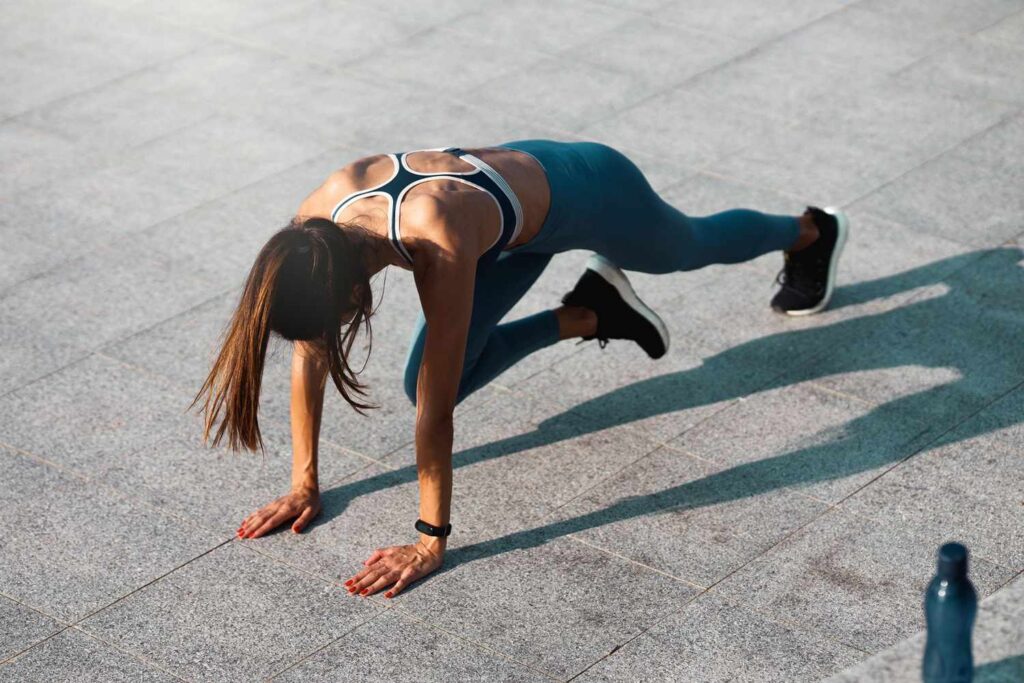
If performed correctly, this exercise offers a thorough cardio and abdominal workout. The mountain climber exercise strengthens the legs, glutes, hips, and abs.
Additionally, it can aid in fat-burning and muscle-building. To get the most out of it, you must start in the right plank position, bring your right knee to your chest, and then push yourself back out as if you were “running” against the floor.
Start out slowly and then pick up the speed gradually. Perform 8–10 reps in each set.
Swimming:

Swimming is more than just a good time in the summer. It benefits both your heart and the tone of your muscles. It might also aid in weight loss. To lose weight, it is essential to combine the correct diet with exercise, as with all forms of exercise.
The quantity of calories you burn while swimming depends on a number of variables, such as:
duration, intensity, swim stroke, weight, swim efficiency
Getting started:
Start with one to three weekly swims of 10 to 30 minutes.
Every week, lengthen your swim by 5 minutes.
To work additional muscles, vary your strokes.
When you swim farther and faster, you burn more calories. The freestyle stroke, which is the quickest type of swimming, offers the most potential for calorie burning. However, that does not imply that you should always choose the freestyle when you enter the pool.
Duration and frequency are the main factors that determine how many calories you burn. You might swim farther if you favor the breaststroke to the freestyle. Additionally, you could burn more calories and be more consistent.
Speed, duration, and frequency:
The amount of calories burned is influenced by time, frequency, and distance.
Breaststrokes, for example, can be performed for a longer length of time than a few laps of freestyle, making them easier to maintain and perhaps more calorie-efficient.
Gradually increase your swimming ability as you learn. Despite the fact that swimming is an impact-free sport, your risk of injury increases when you do too much too quickly.
Start with swimming for 10 to 30 minutes once to three times a week. Take an extra five minutes per week.
It’s best to start off slowly whether you want to attempt swimming for fitness or weight loss. You will reduce your chance of injury if you progressively increase your swimming frequency and intensity.
Finding a stroke you like can keep you motivated and encourage you to swim longer and more frequently.
Additionally, ensuring that you consume enough of the correct meals might help you achieve a calorie deficit and yet have enough energy for your activity.
Jumping Rope:
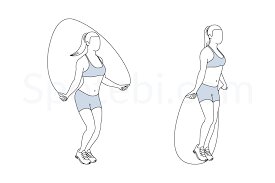
Jump roping is a total-body exercise that can build your muscles and enhance your cardiovascular health. It will help you lose weight by burning calories in addition to improving your cardiovascular health and muscular strength.
The amount of calories burned while exercising mostly relies on the length, intensity, and weight of the exerciser.
The jump rope is a powerful exercise that burns a lot of calories quickly. For instance, a 200-pound (91-kg) person can burn up to 241 calories during 20 minutes of jump rope. As a result, incorporating jump rope into your regular activities will help you achieve the necessary calorie deficit to lose weight.
It can be a terrific technique to increase your fitness and burn extra calories, but you need still to combine it with other workouts and healthy habits to lose weight permanently.
Jumping rope may be incorporated into your fitness routine in many wonderful ways. It can be incorporated into another activity or used as the sole exercise, depending on your skill level and fitness objectives. Although you can adjust your workouts to suit your preferences, you can attempt the following suggestions.
Endurance workout
Start a stopwatch, and then see how long you can jump at a steady rate without stopping. If you can, take a quick break and repeat this.
Try to extend your jumping time over time; ideally, strive for up to 20 to 30 minutes without pausing.
Warmup
Before engaging in another activity, consider jumping rope for three to five minutes at a steady, moderate speed to let your muscles warm up.
Finisher
Jump quickly for a count of 100 times to close out any exercise. After a brief respite, continue leaping in 100-jump intervals until you reach 500 or more total leaps.
If you’re pressed for time, you may also do this as your own workout. Try to complete as many intervals in 10 to 15 minutes.
Mid-workout
If waiting between sets during weight training is something you dislike, consider skipping rope for 30 to 60 seconds to maintain your pulse rate.
Jumping rope can be incorporated into your daily routine or used as a whole workout. You may simply modify your jumps based on your fitness needs and goals because you have control over their length and speed.
Hiking:
Hiking is a great way to keep physically active while taking in the views and sounds of nature.
Though larger expeditions can last days or weeks, many individuals walk on trails or routes for a few hours. The level of difficulty varies according to the degree of aridity and other elements like temperature and climate.
Your weight and the trail grade, or how steep the path is, both have an impact on the number of calories you can burn while hiking.
Weight and route grade are the two key factors that affect how many calories you burn when hiking. The quantity of calories burned per hour rises if a steeper trail is selected.
By increasing your calorie expenditure, hiking may help you lose weight. It is linked to larger gains in mental health than indoor exercise. The number of calories you burn when hiking depends on a variety of factors, including your weight, how long you go for, how steep the terrain is, and the temperature.
As a rule, hiking uses steeper terrain than walking, which results in greater calorie expenditure. However, for a half-hour, running burns more calories than hiking. This type of outdoor exercise has a number of advantages, such as gains in lower body strength, mental health, and weight loss.
Kickboxing:
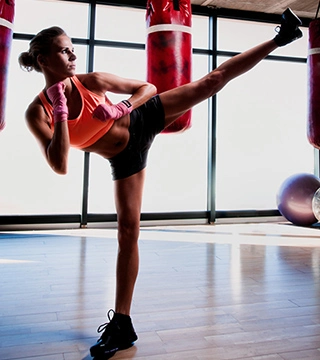
Cardio kickboxing is a type of group exercise that combines martial arts routines with vigorous cardio. This demanding workout is a challenge for athletes of all skill levels.
With this enjoyable and difficult workout, you may burn calories while gaining lean muscle, increasing stamina, coordination, and flexibility.
You can anticipate a full-body exercise that works every muscle in your body, with a heavy emphasis on your core, in a cardio kickboxing session. Cardio kickboxing’s quick motions can help you develop quicker reflexes and enhance flexibility, balance, and coordination.
Between 350 and 450 calories an hour can be burned while doing cardio kickboxing. Cardio kickboxing is a powerful way to let irritation and stress out. It causes the production of hormones (endorphins) that elevate your mood and suppress pain perception.
Make sure to follow these steps for your first class:
Dress comfortably for exercise and put on your running shoes. You can choose to work out barefoot in some gyms.
Bring a small towel and water.
Obtain all required documents signed before class by arriving a few minutes early.
Try to locate a space in the center, close to the back. During class, instructors frequently change positions, and various combinations may cause you to turn in a different direction. To follow along, you’ll need someone to always be in front of you.
Look for a 30- to 60-minute class that you can attend on a regular basis, say three times per week if you want to continue to benefit from the ongoing health advantages of doing a group exercise class like cardio kickboxing.
Rowing:

A great exercise that benefits heart health is rowing. Additionally, it promotes calorie burning, which could aid in weight loss.
The most popular machine for rowing is the flywheel rower. Rowing is a traditional activity aimed to simulate the motion of rowing a boat.
Rowing is an excellent exercise if you want to lose weight and burn calories.
Usually, a modest calorie deficit of 500 calories or less per day is a decent place to start. Regular rowing is an excellent way to help reach this deficit.
Rowing increases weight reduction since it burns a lot of calories, but you should still maintain a healthy diet while doing it.
How to row:
First, take a seat on the pad and fasten the straps around your feet.
Activate the electronic tracker next. When you start rowing, certain models switch on automatically.
Your thumbs should be around the oar while you hold it loosely.
Starting in the “catch” position, with your arms straight, shoulders in front of hips, and shins nearly vertical, bend forward at the hips.
Pushing with your legs and swinging your torso back in a vertical position will then allow you to get into the “drive” position.
After then, lift your arm into the “finish” position. With relaxed shoulders, slide your hands away from the flywheel in a straight line.
Returning to the starting position will usher you into the “recovery” phase.
Allow your arms to advance before tilting your torso forward and bending your legs.
Continue till the time is reached.
The four stages of rowing are known as catch, drive, finish, and recovery. Give yourself time to perfect the technique before progressing to more difficult sessions because this exercise requires significant muscle synchronization.
Butt kicks:
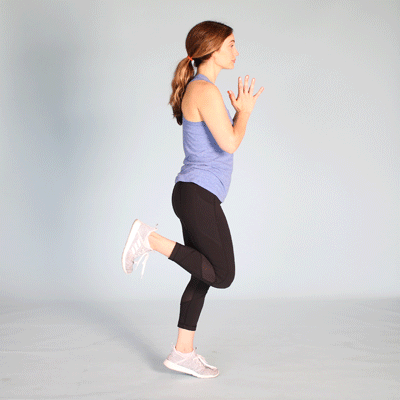
Butt kicks are a sort of plyometric exercise, often known as jump training. With simply your own body weight acting as resistance, they are effective aerobic workouts that strengthen your muscles and increase your cardiovascular system’s efficiency. It promotes calorie burning and weight loss.
Butt kicks are simple to do and can be done practically anywhere, whether in your living room, in the gym, or on a track.
To test this exercise:
Start by standing with your arms at your side and your feet about hip-distance apart. By tightening your hamstring, slowly pull your right heel to your buttocks.
Reset your right foot’s ball on the ground, then move your left heel towards your buttocks slowly.
Repeat this action a couple more times, rotating your heels and increasing your pace each time.
When it feels like you’re running in place, quicken your speed and continue alternating your right and left heels.
Pump your arms as you do this to simultaneously train your upper body. Pump your right arm in a 90-degree motion forward if your left heel is kicking your buttocks. Pump your left arm in front of your right heel kicking.
Maintaining an emphasis on fast leg turnover, continue the practice for at least 30 seconds.
As you improve your fitness, you may extend the time.
If you intend to include butt kicks in your running regimen, perform them prior to beginning your mileage tracking. Butt kick routines might aid in preparing your muscles for the next task. They can also assist you in maintaining proper running form.
Pick three or four plyometric exercises, and perform them all for 30 seconds each. Between each workout, take a 30- to 2-minute break. Repeat your program and work up to a 15 to 20-minute workout duration.
Jumping jacks:
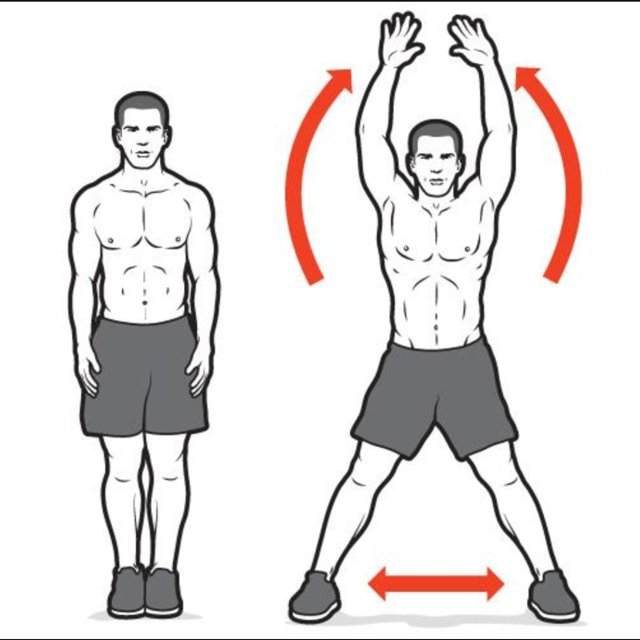
Jumping jacks may appear like a simple workout, but they have several powerful advantages, like strengthening your muscles and enhancing your cardiovascular system.
Jumping jacks are a wonderful exercise that raises your heart rate, builds muscle strength, and increases endurance.
Each person will burn calories at a different rate. For a person who weighs 120 pounds, jumping jacks may burn up to eight calories per minute, and for someone who weighs 250 pounds, up to 16 calories per minute.
There are two methods to do this:
Perform a high number of jumping jacks slowly. Perform a small number of jumping jacks quickly.
Jumping jacks can help you burn calories, but your metabolism also has an impact.
It depends on several variables, such as height and weight, age, and sex.
Jumping jacks can help you lose weight while also improving your cardiovascular fitness and aerobic ability.
The common jumping jack is a wonderful calorie burner, but if you want to mix things up and make your exercises more interesting, there are a few different ways you can modify the exercise to make it more difficult or focus on various parts of your body.
High-knee running:
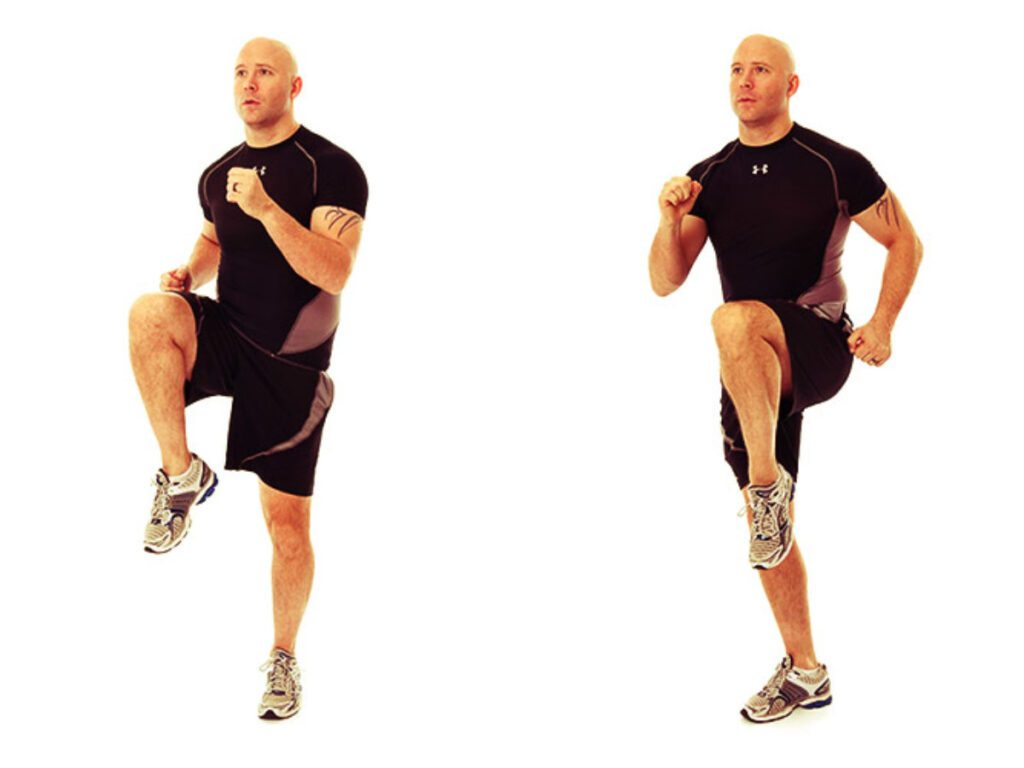
Although high knees seem like a simple exercise, doing numerous repetitions of this intense action makes your heart beat, your lower body and core muscles tighten, and your mind race. you quickly begin to sweat.
Make sure you are wearing supportive shoes that are comfortable before you begin. If you can, try to perform this exercise on a firm gym floor or patch of grass, especially if you are prone to knee or ankle pain. In light of that,
here’s how to perform high knees:
Take a tall posture with your arms at your sides and your feet around hip-to-shoulder distance apart.
Open your chest and engage your core while maintaining a straightforward gaze.
Pull your right knee up to just over waist level towards your chest.
As you do this, simultaneously pump your left hand up.
Put your right leg and left hand down quickly.
Continue by using your left leg and right hand.
Alternate between your right and left legs for the allotted duration.
High knees may be performed with nothing more than your body weight and a pair of supportive shoes. High knees are regarded as a form of cardiac workout. You’ll feel your breathing and pulse rate pick up speed shortly after starting the exercise. You’ll also burn calories as you switch between your knees and arms.
On most calorie calculators, raising one’s knees is seen as a callisthenic activity. Exercises like high knees, which are callisthenic in nature, can burn roughly 7 calories per minute when done aggressively. You may anticipate burning 3.5-7 calories per minute if you’re operating at a moderate pace.
The high knees exercise increases calorie burn, lower body strength, and endurance, improves coordination, and develops the abdominal muscles. It also enhances cardiovascular endurance.
Jump Lunges:
Lunges should burn around 5.7 calories per minute, which translates to 344 calories burned per hour with moderate effort and roughly 515 calories burned per hour with severe effort.
Lunges and other comparable workouts may burn a lot of calories, but how many depend on your weight and body type.
Performing Lunges:
Your hands should be by your sides while you maintain a lofty stance.
While performing lunges, keep your gaze forward at all times. Brace your abs and be sure to lock them in.
Step forward firmly and assume a split stance.
When flexing your legs, your rear knee should be roughly an inch from the floor. When performing lunges, make sure your knee does not touch the floor.
Your front shin should be vertical, or very nearly so. The knees are placed under a lot of strain if you allow it to go past your toes.
You should be standing with your front leg forward and your rear thigh nearly vertical.
Do all of your reps lead with the same leg or, if you’d like, alternate legs, then push off your front leg and return to the beginning position.
With one lunge, about 0.3 calories are burnt.
The number of calories burned during a stationary lunge depends on your weight and effort. There are 20 lunges every minute or around three seconds per lunge.
Lunging is a high-intensity exercise. A 30-minute lunge session will burn 275 calories for a person weighing 150 pounds.
Squat To Press:
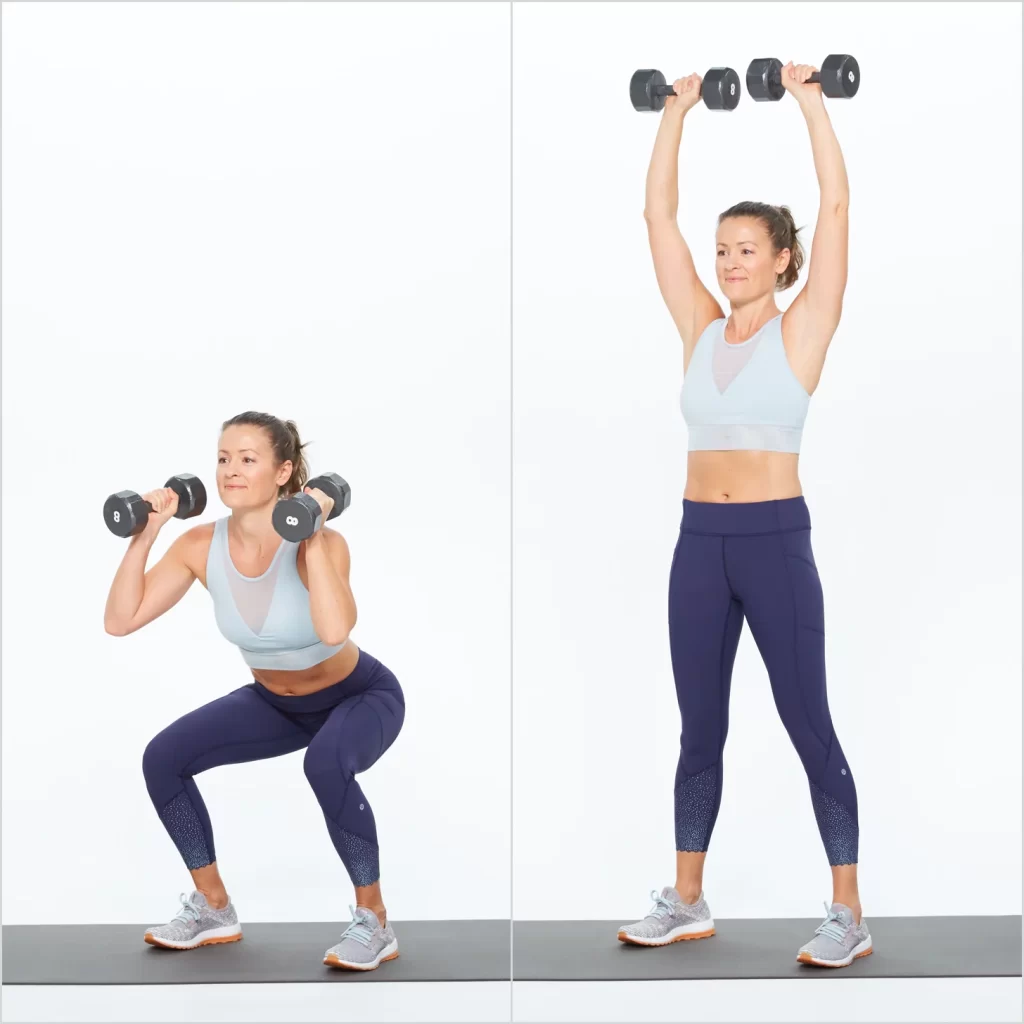
A combination exercise that uses weights is the squat to press. It is a wonderful choice for people who want to lose weight quickly because it combines cardio and strength training.
Your entire body is worked out from head to toe during a squat to press.
How to do a squat to press in a single motion:
Step 1: Stand straight and shoulder-width apart. In each hand, hold a dumbbell. The arms will continue to be sideways.
Step 2: Enter a full squat at this point. This instructs you to squat as deeply as you can.
Step 3: Get up, perform a bicep curl by touching the dumbbell to your shoulders, and then extend your arms above your head. Keep in mind that the dumbbells should point up at the roof.
Step 4: Resume your original stance by bringing your elbows to your sides.
Repeat!
You newbies may complete 10 to 15 of these exercises and at least 4 sets. Others can certainly complete sets of at least five and counts of 20 to 25. You can perform it similarly to a Tabata. So, after a 45-second round, relax for 5 seconds before starting over. Make 3–5 of these rounds.
Plank:
Depending on body weight, the plank is a very effective isometric exercise that burns between two and five calories per minute. An isometric exercise involves using a specific group of muscles while remaining still.
Several variables affect how many calories you burn while planking. These include body weight, metabolic rate, and the proportion of muscle to fat.
You will burn more calories if you perform more reps. Additionally, you will burn more calories during the rest intervals between plank reps if your muscle-to-fat ratio is high.
There are several plank versions that are more difficult than the standard plank. These might also increase calorie burning.
The plank exercises all of your abdominal muscles when performed correctly.
When performing a plank, it’s critical to have proper form in order to maximize results and safeguard your lower back. If your body is in the wrong position, performing a one-minute plank is less effective at growing muscle than performing a 20-second plank with good form.
How to perform?

Lie on your back on the mat.
Keep your elbows directly beneath your shoulders as you raise your torso to rest on your forearms.
Squeeze your glutes and inner thighs together.
Indent your toes.
To activate your core, pull your belly button in and upward.
While keeping your back flat and straight, lift your knees.
Hold your entire body straight, with your neck at ease and your head’s crown extending a little forward as if you were pressing against an imaginary wall.
Maintain your focus on the ground.
Start by maintaining a flat back for 20 to 30 seconds as long as you can. Build up to remaining in this posture for at least a minute. There is no special equipment required for a plank, though you might feel more at ease exercising on a mat as opposed to carpet or hard flooring.
Plank variations: Try these to make the exercise more challenging, effective, and calorie-burning:
Leg-lifting plank:
Put yourself in the standard plank position.
For a minute, alternate elevating your legs without bending your knees.
side plank:
Lie down straight on your right side.
Raise your entire body while maintaining your feet together and your right forearm firmly planted on the floor.
Straighten out your left arm and extend it above your head.
Maintain this position for 30 to 50 seconds.
Perform on the other side of the body.
Resistance plank:
Wrap the resistance band’s ends around your wrists.
Assume the posture of a simple plank.
To boost the muscle burn in your biceps and upper body, stretch out one wrist at a time and hold the position for a few seconds.
By wrapping the resistance band’s ends around your ankles and extending each one individually, you can perform a resistance plank as well.
Kayaking:

Kayaking has the potential to be a fantastic exercise that works every muscle in the body. Kayaking is a sport that completely changes your body, affecting everything from your abs to your shoulders and from your arms to your back. Even better, the activity will uplift your spirits, enhance your mental health, and give you a surge of feel-good endorphins that will make you have a wonderful time.
The following three elements will determine the actual quantity of calories burned:
your height
Weight
the intensity of your exercise
While paddling down a river in the sunshine will be more relaxing and enjoyable than battling the elements on a series of rapids, both will undoubtedly be beneficial.
An average-weight paddler of 125 pounds will burn 150 calories in roughly 30 minutes of kayaking, or 283 calories per hour. A paddler who weighs a little bit more, say 150 pounds, will burn a little bit more, at 340 calories per hour.
Generally speaking, the more weight you have, the more calories you burn. An impressive 454 calories could be burned by a 200-pound kayaker in just one hour of paddling!
Kayaking is an aerobic exercise that will make your heart race. Your entire body is put to work in this monotonous, difficult task. This is a fantastic alternative for engaging, thrilling exercise – it sure beats running for miles on a treadmill! Moving the vessel over the water is taxing on your body, making it a terrific pick!
With cardio, you can work on building strength, losing weight, and burning calories all at once. Additionally, it is a lot of fun and probably won’t even feel like exercise! You’ll soon see that weight change into muscle if you establish a pattern and maybe try mixing up your kayaking excursions with paddleboarding, swimming, or surfing to keep things interesting.
Kettlebell Circuits:
Kettlebell workout that burns body fat all over. Follow these four exercises for 10 rounds to lose weight and get in shape. This is how you complete the entire circuit.
This kettlebell circuit will assist you in achieving your desired outcomes in just four moves if you want to reduce your caloric intake and get lean.
You’ll perform 10 rounds with up to a minute and a half of break in between using a kettlebell that weighs between 25 and 35 pounds. This full-body exercise program contains strong exercises like deadlifts, lunges, rows, and alternating push presses, so it doesn’t matter if you’re working out at the gym or at home.
This is the procedure,
KETTLEBELL WEIGHT: 25 to 35 lbs./12 to 16 kg.
NUMBER OF ROUNDS: 10
90 seconds of rest are allowed in between rounds. You will have performed 400 repetitions by the time the complex is over, burning an enormous amount of calories while moving in several different planes. Maintain a high level of effort without sacrificing quality.
Powerful Deadlift:
With a kettlebell between your legs, stand with your hips shoulder-width apart. To begin, hinge your hips and hold a kettlebell. Next, perform an explosive deadlift, jumping as high as you can when you finish. Land gently, then reload for one repetition. Perform 10 repetitions.
Halo While Alternating Reverse Lunges:
Hold a kettlebell by the horns and hold it upside down to begin. Put your left foot forward and lunge backward. Return to standing and halo the kettlebell anticlockwise after tapping your knee to the ground. For one rep, turn the kettlebell clockwise and repeat on the right side. Perform 10 repetitions.
Ballistic Row:
With a kettlebell in your right hand and your feet shoulder-width apart, start by hinging your hips. Row with your right elbow by forcefully pulling it back; release the row when the handle is close to your belly; then switch to your left hand and row with your left arm. Repeat this motion for one rep. Perform 10 repetitions.
Alternating Push and Press:
With a kettlebell in your right hand, stand. Starting with a slight bend in the knees, press through the heels and quickly press the kettlebell overhead, extending the wrist at the top. For one rep, bring the kettlebell back to the rack position. Ten repetitions, then switch sides.
Calisthenics:
Callisthenics is a type of strength training that uses your own body weight to work out various body parts.
Due to the fact that the movements you perform in calisthenics require you to push or pull against a resistance, it is often referred to as resistance training.
You perform numerous repetitions of each exercise to help build muscle while extending the duration of the workout. Callisthenics can be used as a warm-up or cool-down before engaging in another exercise program or sport. Or it might serve as its own exercise.
Calisthenics are quick exercises that include moving most or all of your body. Ten to twelve repetitions are done for each exercise. Depending on your stamina, you can do more as you improve.
- Callisthenics exercises include, for instance:
- Jumping jacks
- Trunk twists
- Push-ups
- Pull-ups
- Chin-ups
- Sit-ups
- Planks
- Lunges
Depending on your level of fitness, calisthenics can be beneficial. The exercise assists novices who can only perform 10–12 repetitions at a time to develop their muscle strength. Callisthenics can enhance muscle endurance, or how long you can continue the exercise, once you can complete more repetitions.
The effect would still be pretty noticeable even though you wouldn’t burn calories as quickly as you would when lifting weights.
Our calories burned calculator can assist you if you want to figure out how many calories you burned during a calisthenics session.
Altering your body position during exercises might also make them more difficult. When performing push-ups, try lifting your legs on a step or a platform. Your muscles will be put under additional stress as a result, of increasing strength. You might appear leaner after adding muscle. Calisthenics may also aid in increasing your body’s flexibility.
Calorie expenditure during calisthenics is influenced by a number of factors, including age and weight. A 30-minute calisthenics session typically burns 135 calories for a 125-pound person.
Your calorie burn will be more in line with this if you engage in strong calisthenics for 30 minutes:
240 calories for a 125-pound individual.
calisthenics can help a person who weighs around 155 pounds burn up to 167 calories in 30 minutes.
Additionally, you can burn between 300 and 400 calories by doing calisthenics for an hour.
Circuit training:
Circuit training puts the body under a special kind of stress that is different from regular workout activities like weight lifting and cardiovascular conditioning because of its high pace and continuously changing nature.
The challenges of circuit training tend to evenly and thoroughly prepare the body. One of the best methods I’ve found to condition your complete body (and mind) is circuit training.
Circuit training can be completely tailored to meet your individual needs.
Types of Circuit Training:
Timed Circuit
Competition Circuit
Repetition Circuit
Sport-Specific or Running Circuit
One of the best forms of exercise is circuit training since it promotes outstanding overall fitness, tone, strength, and a loss of weight and body fat. In other words, get the most outcomes in the shortest amount of time.
High-Intensity Interval Training (HIIT):
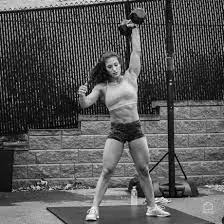
By assisting in an increase in calorie burn as well as a decrease in body fat, heart rate, and blood pressure, HIIT may offer the same health advantages as regular exercise in less time. Even blood sugar levels and insulin sensitivity may be helped by it.
In HIIT, short bursts of intense exercise are separated by periods of lower-intensity recovery. It’s intriguing that it could be the workout that burns the most quickly.
A normal HIIT workout lasts 10 to 30 minutes.
Even though the activity was brief, the health advantages were comparable to doing twice as much moderate-intensity exercise.
Sprinting, riding, jumping rope, or other bodyweight exercises may be a part of the workout.
As an illustration, a HIIT workout on a stationary bike might be 30 seconds of vigorous, high-intensity pedaling, followed by several minutes of relaxed, leisurely cycling at a moderate level.
One “round” or “repetition” of HIIT would be this, and an average exercise would consist of 4-6 reps.
Depending on the activity you select and the level of intensity you exercise at, the precise period of time you exercise and recuperate will change.
No matter how you choose to use this technique, high-intensity intervals should consist of brief bursts of intense activity that raise your heart rate.
HIIT may provide some unique health benefits in addition to providing the benefits of longer-duration exercise in a shorter amount of time.
By practicing HIIT, you may burn calories rapidly.
The number of calories burnt after HIIT, weight training, running, and bicycling for 30 minutes was compared.
HIIT burns between 25 and 30 percent more calories than other types of exercise.
HIIT repetition consisted of 40 seconds of recuperation followed by 20 seconds of maximal exertion.
Despite the fact that each activity in this study lasted 30 minutes, HIIT activities usually last far less time than conventional exercise sessions.
This is due to the fact that HIIT allows you to work out for a shorter amount of time while yet burning a similar amount of calories.
HIIT can raise your metabolism for several hours after you finish because of how intense the activity is. You will continue to burn calories as a result long after your workout is complete.
High-intensity interval training can provide fat loss that is equivalent to traditional endurance training albeit with a substantially less time commitment. They can also shrink the waistline.
If you are not very active, beginning HIIT may help you grow muscle, but not as much as you would if you were weightlifting.
In particular, those who are overweight or obese and who have high blood pressure can benefit from HIIT’s ability to lower blood pressure and heart rate.
Sprint Interval Training:
Short bursts of exercise performed at a maximum effort followed by a lengthy time of rest make up the two halves of the advanced workout known as SIT.
SIT is more explicitly characterized by recurrent, brief intermittent bursts of all-out activity, often 4-6 bouts of up to 30 seconds each, separated by active or passive recovery periods, typically lasting approximately 4-5 minutes.
SIT is a great exercise to include in a plan for advanced fitness. It’s a terrific approach to increase athletic performance and aerobic and anaerobic fitness since it enables you to exert your maximum effort in the shortest period of time.
HIIT frequently tops the list of well-liked workout fads. There are other ways to burn calories quickly besides using this exercise technique, which has several advantages including a high-calorie burn.
SIT causes similar increases in cardiorespiratory fitness and calorie burning.
Both HIIT and SIT burn calories, although some evidence suggests that SIT reduces fat more effectively.
The precise number of calories burned during an SIT session relies on your body weight, the length of the exercise, and the total intensity. It might be challenging to calculate the precise quantity of calories because of the rest periods.
SIT is not for newcomers. It is a strenuous routine best suited for individuals with advanced fitness levels. Furthermore, those with specific medical problems, chronic pain, or injuries may find it inappropriate because it needs close to the maximum to maximal effort.
How to be performed:
Warm up with modest cardiovascular activity, such as running in place, for at least 3 minutes. Stretching movements like leg swings, high knees, and walking lunges should be done after this.
After that, begin your interval training:
Finish 3–4 sets of 20–30 seconds each at an intensity of 10—your maximum effort.
After each sprint, take 4-5 minutes to relax. These downtimes might be spent doing nothing but resting or doing a little exercise like walking. Maintain a 1-2 level at all times.
Prior to increasing the number of workout intervals or shortening the rest periods, perform this program 2-3 days per week for a few weeks.
Burpees:
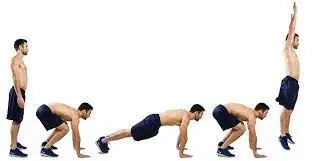
Burpees are a strenuous exercise that uses a lot of your body’s primary muscle groups.
A burpee is essentially a two-part exercise because it starts with a pushup and ends with a leap into the air.
Burpee repetition fatigue is common, but the benefits of this adaptable exercise may be worthwhile, especially if you’re wanting to improve your aerobic fitness and burn calories while gaining strength and endurance.
In a minute, the typical person can complete 20 burpees. By executing burpees continuously for one minute, you can determine how many calories you can burn using this data.
A 155-pound person can burn roughly 250 calories doing burpees for 20 minutes.
How to perform a burpee properly;
Start by standing with your feet shoulder-width apart, bending your knees, and keeping your back straight.
Place your hands on the floor in front of you, inside the soles of your feet.
Kick your feet back, assuming the pushup position while standing on your hands and toes and bearing your weight with your hands.
Perform one pushup while maintaining a vertical posture from head to toe. Don’t slouch or stick your butt up in the air, please.
To execute a frog kick, spring your feet back to their starting position.
Stand and raise your arms above the head.
Leap into the air quickly so you land where you started.
Squat down and complete another repetition after you land with your knees bent.
You can burn more calories by doing burpees more forcefully.
Snorkeling:
Snorkeling is one of the most exciting and distinctive pastimes there is. It gives the swimmer more aerobic and physical strength while also being entertaining and educational.
A snorkeler can spend many hours or a whole afternoon swimming among the corals and fish with only the most basic equipment. Time may pass quickly.
Like swimming, it has little impact and is advantageous for people with joint problems. Due to the water’s resistance to natural movement, snorkeling is a fantastic exercise for building muscle.
Depending on the effort, snorkeling burns between 250 and 350 calories each hour. Snorkeling sessions typically last 90 minutes and involve moderate activity, burning between 400 and 500 calories.
Snorkeling is not quite like floating in a pool on a lilo. Despite the fact that it is a fun leisure activity that unknowingly lasts the entire workout, it is physically demanding.
Several methods, in fact.
The snorkel really prevents air from reaching the lungs. You are breathing through a tube, so it is a little difficult, but not permanently. Your heart rate rises as a result, increasing the number of calories you burn.
The same is true for diving underwater. A similar result is produced by a quicker heartbeat in you.
Compared to air, water is 830 times denser. Your muscles must work harder to go through it since it is considerably more difficult to do so.
Elliptical:
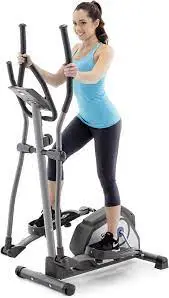
Exercise on an elliptical machine is a fantastic way to gain muscle, burn fat, and improve cardiovascular health. When calculating how many calories you will burn while using an elliptical machine, it is important to take into consideration both your body weight and the intensity of your exercise.
You may get aerobic exercise while placing the least amount of stress on your joints by using elliptical trainer equipment. People who wish to increase their strength without placing too much strain on their hips, knees, and ankles should use an elliptical machine because of its smooth action.
Low-impact exercises that increase cardiac fitness and burn calories can be performed on an elliptical machine.
Your age, weight, and gender are just a few of the factors that affect how many calories you burn specifically. Calorie burn can also be affected by your workout’s intensity, tempo, and resistance level.
Depending on your body weight, a 30-minute elliptical activity could result in a calorie burn of 270–378.
An elliptical workout lasting 30 minutes burns roughly:
270 calories for a 56.7 kg person
324 calories for a 70.3 kg person
378 calories for an 83.9 kg person
Your age, gender, and body mass index (BMI) are other variables that determine how many calories you burn.
For instance, persons who weigh more and have higher muscular mass typically burn more calories.
Your exercise program’s rigor also matters. You will burn more calories if you perform a high-intensity workout, such as high-intensity interval training (HIIT) or another high-intensity exercise employing more resistance at a faster pace.
To keep your exercises interesting, focus on new muscle areas, and continue to challenge yourself, you may switch up your elliptical program. Each session must always begin with a warm-up and end with a cooldown.
Strength training:
A weight-training activity offers additional significant advantages while often burning fewer calories than a cardio workout.
For instance, weight training is better at developing muscle than aerobics, and muscle burns more calories at rest than some other tissues, such as fat.
As a result, it is often believed that adding muscle is the secret to raising your resting metabolism, or the amount of calories you burn when at rest.
Weightlifting increased men’s resting metabolism by 9%. Women saw less of an impact, with an approximately 4% rise.
Most exercises will increase your calorie burn as your weight increases.
Jogging for 30 minutes at a moderate pace will burn about 250 calories for someone who weighs 160 pounds (73 kg). You would burn about 365 calories in 30 minutes if you run at a quicker rate of 6 miles per hour.
However, you could only burn 130–220 calories if you weight train for the same period of time. When compared to weight training, cardio frequently produces a larger calorie burn each session for about the same amount of exertion.
Your body size and the level of intensity you exercise determine how many calories you burn when working out. Typically, a workout that combines both cardio and weightlifting will burn more calories overall.
The men’s daily resting metabolic rate went increased by roughly 140 calories. It was just approximately 50 calories per day for women.
Therefore, while weight training and adding a little bit of muscle may slightly boost your metabolism, it won’t cause it to soar.
However, weightlifting also has extra, very important benefits for calorie burning.
Working out harder will result in burning more calories later for the majority of workouts. Over time, weight exercise could boost your metabolism, though the improvements won’t be dramatic. Additionally, weight training often increases the number of calories you burn after a workout more than exercise does.
Metabolic Training Circuit:
The term “metabolic training” refers to a training method that maximizes calorie burn both during and after exercise. You must exert your utmost physical effort through a sequence of complex motions (working many muscle groups at once) for a brief, intense amount of time to get this result. While the workouts are shorter than a usual cardio or strength training session, they are far more intense.
The exercises themselves are really powerful. Depending on the activities you do and how hard you work, you may burn as many as 600 calories in a single session, according to some estimates.
The scientific name for the “afterburn” effect is post-exercise oxygen consumption or EPOC. Afterburn is when your body continues to burn calories for several hours following an exercise. Afterburn is comparable to momentum.
Compound exercises with resistance performed with high intensity are used in metabolic training. As a result, more muscle is recruited, used up, and growth hormone, which is essential for building muscle, is naturally released.
Strength training workouts that focus on several different muscle groups are the greatest for metabolic conditioning. As opposed to “isolated” motions, which only target one muscle group at a time, these are referred to as “compound” movements. As an example, a cable pull-down isolates the triceps, whereas a push-up simultaneously engages the triceps, shoulders, core, and chest.
Metabolic training sets’ exercises:
As usual, get your body ready for work by beginning with a 5-minute warm-up. This is crucial to ensure that your body is prepared to work hard and to prevent injuries.
It’s time for your metabolic training circuits after your warm-up. Returning to the circuit we created earlier, your workout might resemble this…
[30 SECONDS] Pushups
[15 SECONDS] of rest
[30 SECONDS] Jump Squats
[15 SECONDS] of rest
[30 SECONDS] Wood Choppers
[15 SECONDS] of rest
Climbers of mountains [30 SECONDS]
[15 SECONDS] of rest
[30 SECONDS] Speed skaters
[15 SECONDS] of rest
[30 SECONDS] Renegade Row
You would take a short break following the circuit—about two minutes. That is regarded as “1 set”. To finish your workout, you would go through two or three sets.
Your full workout will only take 30 minutes when you include a 5-minute warm-up, 5-minute cool-down, and 5-minute stretch at the conclusion! Even though it may be the hardest 30 minutes of your life, it will only last for 30 minutes.
Battle Ropes:
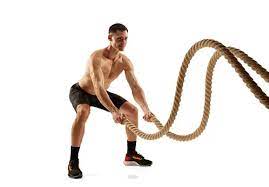
If you’ve ever been to a gym, you’ve probably seen someone hurl big, heavy ropes around. Many people use what is referred to as “battle ropes” for an intense strength-building and calorie-burning workout.
You’d be astonished to learn how difficult lifting and moving those hefty ropes can be, especially for longer than a few seconds, even if it would seem simple to swing a rope up and down.
Most of your body’s muscles, including those in your midsection, shoulders, arms, upper and lower back, and lower body, are worked out by battle ropes.
If you wish to focus on a specific area, you can adjust how you swing the ropes.
For example, unilateral waves (alternating arms) target the external obliques more efficiently than bilateral waves (swinging the ropes with both arms at the same time).
Exercises involving a battle rope are excellent for strengthening cardiovascular and respiratory fitness and improving sports performance. They’re an excellent substitute for other cardio exercises because they have low impact and can be done while sitting.
Aerobic dance:
Burning calories and losing weight while dancing is enjoyable and thrilling. Cardiovascular activity like this strengthens your muscles and raises your heart rate. You can burn between 300 and 600 calories per hour when dancing, depending on how long and how hard you dance.
With dancing, a person who weighs 180 lbs expends about 411 kilocalories every hour. Use our calorie calculator for various activities or fill out the form to determine how many calories you expend dancing.
Legs, arms, and the core are all worked out while you dance. Dancing is a wonderful alternative for weight loss since it helps to burn calories while also building muscle because it combines cardio and strength training. Your heart rate is kept up by the steady movement, which helps you burn calories more effectively.
In addition to its health advantages, dancing is a fantastic method to de-stress and improve your mood. With friends or in a group setting, it is an enjoyable and social exercise. You’ll find it simpler to stick to your weight loss goals and make fitness a regular part of your life if you incorporate dancing into your daily routine.
Work at a moderate to high effort level when dancing to burn the most calories possible. This entails maintaining a high heart rate and using your muscles vigorously during the entire dancing routine. It’s also beneficial to select dance genres like salsa, hip-hop, or Zumba that are considered to be high-energy and burn plenty of calories.
Overall, dancing is a good strategy to lose weight and burn calories. You can quickly reach your weight loss goals by including this enjoyable and social kind of exercise in your daily regimen because it works every muscle in your body.
Zumba:

Zumba is a high-intensity aerobic exercise influenced by Latin dancing that can be a good method to enhance your daily calorie burn and physical activity.
You must expend more calories than you are taking in in order to produce a calorie deficit and so lose weight. You can achieve this by consuming fewer calories each day, getting more exercise, or doing a combination of the two.
With regular strength training sessions, a nutritious diet, and two or three Zumba sessions each week, you might be able to reach your weight loss goals.
Numerous factors, including the following, can affect how many calories Zumba can burn:
Age, weight, present degree of physical fitness, genetics, and exercise intensity
Increasing the intensity of your Zumba workout can aid in boosting the number of calories you burn. Wearing a heart rate monitor will allow you to confirm that your exercise heart rate is between 55 and 85% of your maximum heart rate.
By taking a Zumba variation class, such as high-intensity interval training (HIIT) Zumba, you may also burn more calories and fat. Alternatively, enroll in a Zumba class that incorporates weights.
While having a calorie deficit is crucial for weight loss, it’s also crucial to eat enough calories to maintain energy levels and acquire a balanced diet of vitamins and nutrients.
How to do Zumba:
Zumba has become more well-liked all across the world in the previous ten years. Zumba courses are now offered frequently in most gyms. Zumba can also be available at the YMCA or community center closest to you.
If Zumba classes are not available where you live or you prefer to exercise at home, you may also find workouts online. There are online Zumba videos for weight loss, and body toning, and Zumba for beginners.
These exercises won’t require a lot of equipment. Only breathable clothing, athletic shoes, and an optional set of one- or three-pound dumbbells are required.
Sports:
Sports are an excellent strategy to keep your weight stable. Some sports require a lot of energy, while others use less and burn fewer calories.
You might wish to try some of the following activities that burn the most calories:
- Ice Skating
There are many different ice skating styles, but speed skating burns the most calories in an hour. Up to 800 calories can be burned each hour during speed skating.
This is a result of the way your arms and legs are continually moving to maintain balance while your legs are constantly kicking to increase speed. Additionally, when you attempt to jump or whirl, your entire body must be in motion. - Racquetball
When played competitively, racquetball is regarded as a strenuous cardiovascular sport that can burn up to 600 calories per hour.
Racquetball improves your flexibility in your core as well as your cardiorespiratory and coordination skills. - Basketball
About 740 calories are burned every hour during a full-court basketball game. The scorching agony in your muscles is most noticeable when you first start playing basketball again after a long break.
The intense movements your hands make while dribbling the ball and the little bending of your feet while you are being guarded are the sources of the calories burned. - Tennis (single)
A single tennis match played for fun can burn up to 100 calories per hour, whereas a match played for fierce competition can burn up to 560 calories.
Tennis needs you to continuously engage your upper arm muscles to swing a racquet that weighs about 309 grams. You must step forward with your left foot and bend your feet when swinging a forehand. As you hit the ball, a lot of energy is needed. - Football
Football is a well-known sport that you are likely aware may burn a lot of calories. For persons who weigh 83 kg, a 45-minute soccer half can burn up to 400 calories.
A 110m long football pitch must be run back and forth by a player. Furthermore, not all positions in a soccer game burn calories at the same rates. Compared to midfielders, goalkeepers often expend a lot fewer calories.
Yoga:
A yoga practice can burn anywhere between 180 and 460 calories, depending on a number of variables, such as:
the style of yoga you practice, the length, and how challenging the class is.
whatever gender you may be,
For example, a 60-minute Hatha (basic) yoga lesson will result in 183 calories burned for a 160-pound person.
Burning calories is not the main health benefit of yoga, but you will burn calories while taking a yoga class. The quantity of calories you burn depends on a variety of factors, including the type of yoga you practice, the intensity and duration of the session, and the length of the class.
Hatha yoga, a fundamental kind of yoga that is typically taught at a little slower pace, for instance, burns fewer calories than Bikram yoga, popularly known as hot yoga.
Bikram Yoga
Bikram yoga is practiced in a room that is heated to 105°F and has a humidity level of 40%. The 90-minute session typically consists of 26 postures and two breathing exercises.
Numerous positions call for power, flexibility, and balance. Men burnt 460 calories on average and women burned 330 calories throughout every Bikram session.
Either increasing your physical activity level or consuming fewer calories will help you lose weight. Most people who successfully lose weight and keep it off combine both strategies.
Many exercises burn more calories than yoga.
Yoga may have a variety of benefits that could make it a good choice for long-term, healthy weight loss.
The yoga community offers moral support and role models for those seeking to lose weight. The researchers added that practicing yoga to cultivate mindfulness might benefit people by:
Keep harmful foods away,
to be more in tune with their bodies, to be able to tell when they are full, and to have a smaller appetite
reduced back or joint pain that had been preventing further exercise, and enhanced mood and self-esteem.
Yoga promotes physical, mental, and spiritual development so that you can become the best version of yourself.
Yoga, especially the more active types may also be a useful method for weight loss. However, you also benefited from yoga practice that helps you to lose weight.
Numerous experts agree that yoga can support healthy weight loss in a number of different ways.
Although yoga isn’t often thought of as an aerobic exercise, some forms of it are physically more demanding than others.
The highest amount of calories is burned when practicing strenuous, energetic yoga. This might help prevent weight gain. Ashtanga, vinyasa, and power yoga are a few styles of yoga that require significant physical effort.
Vinyasa and power yoga are regularly offered at hot yoga studios. This type of yoga involves almost continual movement, which helps burn calories.
Yoga may help you tone your muscles and boost your metabolism.
Restorative yoga may help with weight loss even though it is not a particularly physically taxing form of exercise. According to one study, restorative yoga can help obese women lose weight, including belly fat, in an efficient manner.
These findings are especially encouraging for people whose body weight makes performing more demanding forms of yoga difficult.
By burning calories, increasing awareness, and lowering stress, yoga may be a potential strategy to support behavioral change, weight loss, and maintenance. You might be able to cut back on your eating and recognize the negative effects of overeating as a result of these variables.
When should you practice yoga to lose weight?
Yoga can help you lose weight, so practice as often as you can. At least three to five times a week for at least an hour, you can practice more vigorously.
Balance out your practice by taking a softer, more laid-back session on the other days. Yoga sessions like yin, restorative, and hatha are excellent choices.
Start out small if you’re a beginner; start with a 20-minute practice and work your way up from there. This will help you stay injury-free as you gain strength and flexibility. Every week, allow yourself one entire day of rest.
For further cardiovascular benefits, combine your yoga practice with exercises like walking, cycling, or swimming.
Avoid weighing yourself right after a yoga session, especially a hot yoga session, as part of your regular routine because you can lose water weight there.
Home workout poses:
Try these basic poses at home if you don’t have time for a full yoga session.
Sun Salutations:
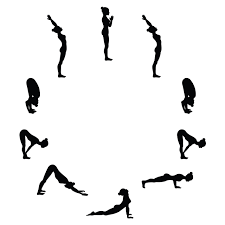
- Perform 10 Sun Salutations at a minimum. You can increase the intensity by holding some poses for extended periods of time or quickening your tempo.
- As you stand and extend your arms aloft, take a deep breath.
- As you swan dive downward into a Forward Bend, exhale.
- Return to the plank position by jumping, stepping, or walking your feet.
- For at least five breaths, maintain this posture.
- Bring your body to the ground by bending your knees.
- Place your hands under your shoulders, extend your legs, and turn the tops of your feet towards the mat.
- By inhaling, assume the partial, full, or lifted position of the cobra.
- Exhale and lower yourself back down after forcing yourself into the downward-facing dog.
- Hold this stance for at least five breaths.
- After jumping, stepping, or walking your feet to the top of the mat, stand in a forward bend while exhaling.
- Then take a deep breath and raise your arms upward.
- To bring your arms back up by your body, exhale.
A boat pose:
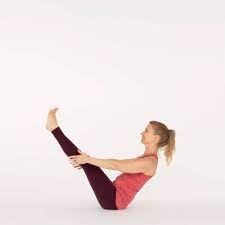
- By integrating every part of your body, especially your core, this position helps you decompress.
- Crossing your legs in front of you, lie down on the ground.
- Lift your feet off the ground while bending your knees such that your thighs are at an angle to the floor and your shins are parallel.
- Make sure your arms are parallel to the ground and extended out in front of you.
- If you can, elevate your torso and straighten your legs.
- For 30 seconds, maintain this posture.
- Repeat a minimum of five times.
Plank pose:
- Spend 10 to 20 minutes in various plank posture variations.
- Lift your heels as if you were seated at a table and step your feet back.
- Your body should be in a straight line. Consider checking your body in a mirror.
- Make use of your arm, leg, and core muscles.
- Hold this position for at least a minute.
FAQS:
Running has the highest calorie burn rate per hour. Swimming, walking, Zumba, sports, and stationary bicycling are other fantastic possibilities. HIIT workouts are excellent for calorie burning. Your body will continue to burn calories for up to 24 hours after a HIIT activity.
Calories are a unit of measurement for food’s amount of energy. The body needs calories to breathe, circulate blood, and engage in physical activity. A sick person’s body could require extra calories to combat a fever or other issues.
You can lose weight and keep it off by increasing your caloric expenditure. You can increase the total amount of calories you burn in less conventional ways in addition to exercising and eating the correct foods.
Sports that Burn The Most Calories · 1. Ice Skating 2. Racquetball 3. Basketball 4. Football 5. Tennis (single) 6. Soccer 7. Running 8. Swimming 9. Volleyball 10. Golfing.
By engaging in physical activity, such as walking or climbing stairs, your body burns calories. But by carrying out the most fundamental physiological processes, it also burns them. For instance, the body needs energy constantly to breathe, regulate body temperature, and pump blood throughout the body. In reality, this kind of passive calorie burn, often referred to as resting metabolic rate (RMR), accounts for between 60 to 75 percent of your total energy expenditure (TEE).
Due to the repetitive synthesis and breakdown of ATP during muscular contraction, exercise increases the body’s caloric consumption. Skeletal muscle contractions are powered by the energy generated when ATP is broken down, which increases the body’s need for energy and increases caloric expenditure.
The term “metabolic training” refers to a training method that maximizes calorie burn both during and after exercise. You must exert your utmost physical effort through a sequence of complex motions (working many muscle groups at once) for a brief, intense amount of time to get this result. While the workouts are shorter than a usual cardio or strength training session, they are far more intense.
The exercises themselves are really powerful. Depending on the activities you do and how hard you work, you may burn as many as 600 calories in a single session, according to some estimates.
Cycling is one of the most effective ways to burn hundreds of calories throughout a workout. Cycling burns a greater number of calories than walking on average.
A moderate cycling activity lasting only 30 minutes will burn 202 calories for the average woman and 225 calories for the average man. Women will burn 404 calories per hour whereas men will burn 450 calories at this increased rate.
If you increase your pace and exert more energy, you can burn 314 calories for a 30-minute session for a woman and 358 for a man on average (that’s 628 and 716 calories for an hour of cycling, respectively).
In a minute, the typical person can complete 20 burpees. By executing burpees continuously for one minute, you can determine how many calories you can burn using this data.
A 155-pound person can burn roughly 250 calories doing burpees for 20 minutes.
Two to five calories are burned as you climb a flight of steps. The average number of calories you lose when climbing seven flights of stairs is 83. About 235 calories should be burned if you climb stairs for 30 minutes. The intensity of your workout and your body weight are the two variables that affect how many calories you burn. Additionally, you burn more calories as you ascend more quickly.
How to do a squat to press in a single motion:
Step 1: Stand straight and shoulder-width apart. In each hand, hold a dumbbell. The arms will continue to be sideways.
Step 2: Enter a full squat at this point. This instructs you to squat as deeply as you can.
Step 3: Get up, perform a bicep curl by touching the dumbbell to your shoulders, and then extend your arms above your head. Keep in mind that the dumbbells should point up at the roof.
Step 4: Resume your original stance by bringing your elbows to your sides.
Repeat!
Yoga can help you lose weight, so practice as often as you can. At least three to five times a week for at least an hour, you can practice more vigorously.
Balance out your practice by taking a softer, more laid-back session on the other days. Yoga sessions like yin, restorative, and hatha are excellent choices. Start out small if you’re a beginner; start with a 20-minute practice and work your way up from there. This will help you stay injury-free as you gain strength and flexibility. Every week, allow yourself one entire day of rest.
Zumba has become more well-liked all across the world in the previous ten years. Zumba courses are now offered frequently in most gyms. Zumba can also be available at the YMCA or community center closest to you.
If Zumba classes are not available where you live or you prefer to exercise at home, you may also find workouts online. There are online Zumba videos for weight loss, and body toning, and Zumba for beginners.
These exercises won’t require a lot of equipment. Only breathable clothing, athletic shoes, and an optional set of one- or three-pound dumbbells are required.
Your age, weight, and gender are just a few of the factors that affect how many calories you burn specifically. Calorie burn can also be affected by your workout’s intensity, tempo, and resistance level.
Depending on your body weight, a 30-minute elliptical activity could result in a calorie burn of 270–378.
An elliptical workout lasting 30 minutes burns roughly:
270 calories for a 56.7 kg person
324 calories for a 70.3 kg person
378 calories for an 83.9 kg person
Callisthenics is a type of strength training that uses your own body weight to work out various body parts.
Due to the fact that the movements you perform in calisthenics require you to push or pull against a resistance, it is often referred to as resistance training.

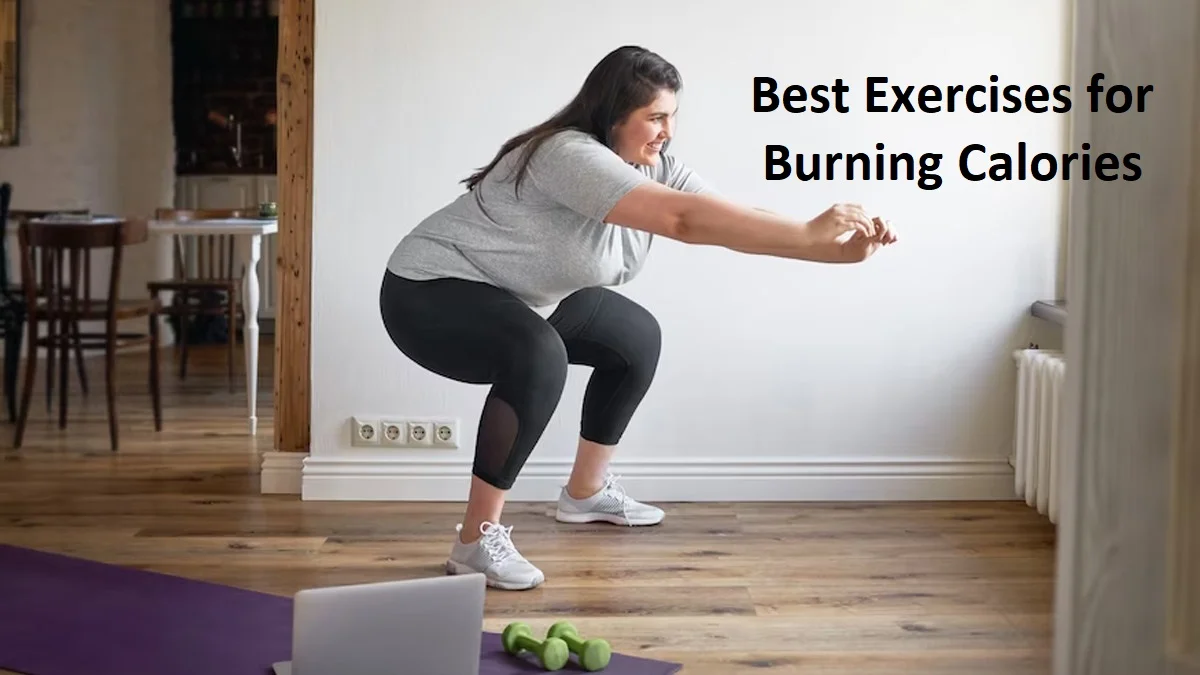

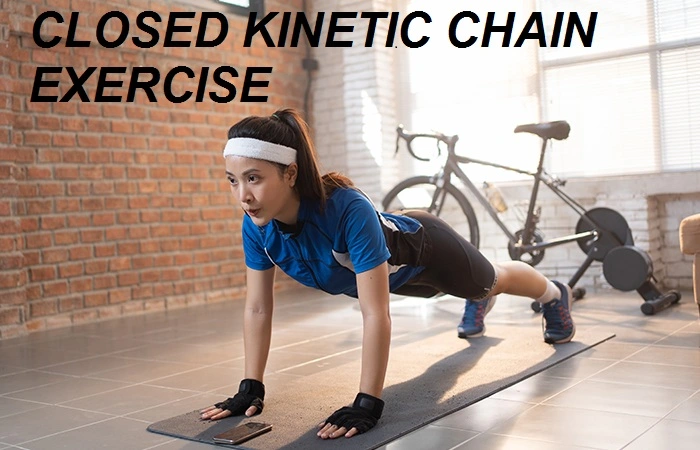
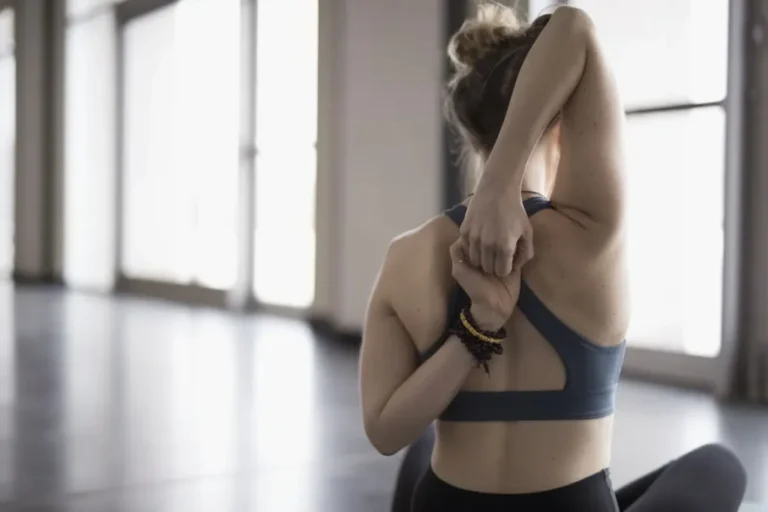
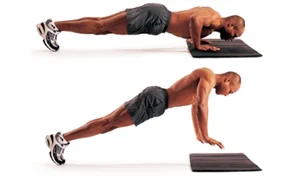


3 Comments